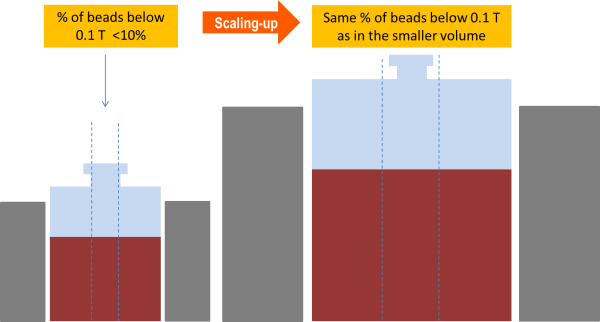If scientists and technicians link their production results solely to the separation time on one specific piece of classic biomagnetic separation equipment, they will not be able to translate that success. This is applied to both different batch sizes or even the same batch size on a different piece of equipment, unless they optimize the separation time for the new conditions.

Instead, one can choose a more modern homogenous biomagnetic separation system such as SEPMAG that allows you to work with different batch sizes and therefore, allows you to easily scale up your magnetic separation process.
This post is about biomagnetic separation in the production of magnetic beads for IVD kits. If you want to know its most important elements, download our free ebook The basic guide to use biomagnetic separation in production processes:
The main production parameter used in classic magnetic separators is the separation time. This separation time is dependent on the piece of equipment and on the scale of production. The process cannot be reproduced with different equipment and cannot be reproduced on a different scale. When production needs to be altered, the magnetic separation step will become the bottleneck because you will have to redefine the parameters in order to change scale.
How to easily scale up your process
In order to overcome these problems, the production process should be performed with a system that has well-defined biomagnetic separation conditions (e.g. SEPMAG systems). With homogenous biomagnetic separators, the conditions are standardized and well understood and the process can therefore be replicated in different systems and in different volumes.
You can define the magnetic separation process by determining three simple parameters:
-
The value of the constant magnetic field gradient. In homogenous separation systems, this value is provided by the manufacturer and can be found on the technical data sheet.
-
The maximal percentage of beads that are initially in suboptimal conditions. If based on magnetite, use the formula % of suboptimal beads 100* = (2* (0.1/gradient)/vessel diameter)2. For other magnetic pigments, substitute 0.1 by the correct saturation field in Tesla.
-
A separation time large enough to allow an acceptable level of material losses. Since there is no risk of irreversible aggregation in homogenous biomagnetic systems, the time can be increased a bit to reduce losses if necessary.
With these parameters known, you can scale your production process either up or down with the same percentage of recovery and with no aggregation problems. SEPMAG technology is the only commercially available technology that can account for all three of the above parameters and that also allows users to control these parameters.
Reproducing the validated process in future biomagnetic separations
In addition, if the amount of beads not saturated at the start of the biomagnetic separation is small (<10%), you can reproduce the validated process in future biomagnetic separations by:
-
Having a magnetic field gradient no higher than the defined field gradient. This ensures that all the beads experience the same force as when the parameters were defined and avoids the risk of irreversible aggregation.
-
Keeping the % of magnetic beads below saturation (Bs) at the initial starting moment of separation equal or less than the defined value, applying the formula and conditions of the new system.
When one uses homogenous biomagnetic conditions the defined nature of the separation step guarantees lot-to-lot consistency even at different volumes. Therefore, scaling up a process is straightforward.
If you found this post about using biomagnetic separation for production useful, don't forget to check these related posts:
- Perfecting the magnetic separation process in magnetic bead IVD kit production
- Avoiding Irreversible Aggregation Problems during Production
- Detect Resuspension Problems with Biomagnetic Separation Processes
Check www.sepmag.eu/ebooks to access to FREE eBooks on the subject, or contact us. We will be glad to help you to achieve an efficient magnetic bead separation process!




